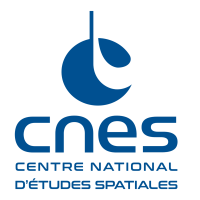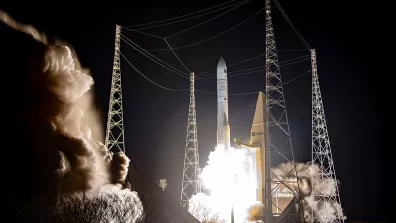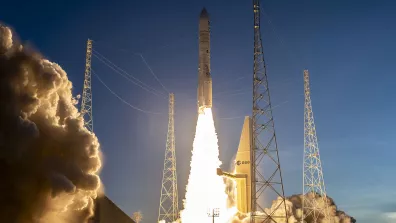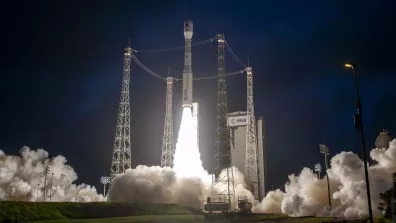12 August at 21:37 local time (13 August, 02:37 CEST), Ariane 6, operated by Arianespace, accomplished a flawless third launch from Europe’s spaceport at the Guiana Space Centre (CSG), placing into Sun-synchronous orbit at an altitude of approximately 800 kilometres the MetOp-SG-A1 (Second Generation A1) Earth-observation satellite for the European Meteorological Satellite Organisation (Eumetsat), built by Airbus Defence & Space under contract to the European Space Agency (ESA). The launch was the third in 2025 from the CSG and the third for Europe’s new Ariane 6 launcher, flying its second commercial mission.
MetOp-SG-A1
MetOp-SG-A1 is the first in the European MetOp Second Generation series of weather satellites. It will ensure continuity of vital global observations from polar orbit, affording more accurate weather forecasts than the first-generation MetOp satellites and deeper insights into Earth’s atmosphere and changing climate than ever before. MetOp-SG-A1 will be carrying six imaging and atmospheric sounding instruments to acquire data in the visible, infrared and microwave portions of the spectrum, crucial for weather forecasting, climate monitoring and a broad range of other services and applications.
IASI-NG
One of these six instruments is IASI-NG (Infrared Atmospheric Sounding Instrument-New Generation), to which the French scientific community and national weather service Meteo France have made a big contribution and for which CNES has overall technical responsibility including in-orbit commissioning. The agency also developed the chain for processing raw data from the instrument into atmospheric characterization data. It is also in charge of developing and operating a technical expertise centre to monitor the instrument’s performance once in orbit.
IASI-NG is a passive infrared remote-sensing instrument designed to determine temperature and water vapour profiles in the atmosphere, record ocean surface and land temperatures and monitor a vast range of chemical compounds as well as 16 essential climate variables that can only be observed from space, including greenhouse gases, desert dust and cloud cover. Extending the data record built up by its predecessor IASI, IASI-NG will be a real asset for atmosphere sciences, particularly numerical weather prediction models, atmospheric composition studies and climate research. Thanks to its innovative optical configuration, the new-generation instrument’s data will be twice as accurate as IASI’s and it is a key element of Europe’s three future MetOp-SG-A series weather satellites.
Sentinel-5 from the Copernicus programme
Also among the six instruments is Sentinel-5 from the European Commission’s Copernicus programme. This sensor dedicated to atmospheric monitoring will deliver daily global data on key air pollutants, essential climate variables and stratospheric ozone.
This 264th launch in the Ariane series marks the third flight for Ariane 6. After its inaugural flight on 9 July 2024, the new modular and versatile heavy-lift launcher has succeeded Ariane 5 and restored Europe’s independent access to space, taking European space transportation into a new era.




